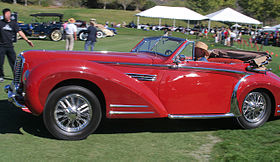Delahaye 175
| Delahaye 175/178/180 | |
|---|---|

1947 Delahaye 175
|
|
| Overview | |
| Manufacturer | Delahaye |
| Production | 1948–1951 |
| Body and chassis | |
| Class | Luxury car |
| Layout | FR layout |
| Related | Delahaye 135 |
| Powertrain | |
| Engine | 4,455 cc type 183 I6 |
| Transmission | 4-speed pre-selector (Cotal) |
Delahaye 175 was an automobile manufactured by Delahaye between 1947 and 1951. The last of the large Delahayes, the type 175 was essentially a brand new chassis and engine. The chassis bore little resemblance to the preceding Type 135, other than the cockpit area with its driveshaft tunnel and welded stamped-steel floor, which assembly formed a rigid structural member. The new 4.5-litre engine was visually quite similar to the Type 135, but significantly improved. It had seven main bearings versus the Type 135's four, and its cylinder head had six intake and six exhaust ports, twelve in all, versus nine in the standard Type 135 ( albeit a rare few Type 135 racing engines had twelve port heads). The larger engine was stronger and breathed better <Club Delahaye archive data, obtained from its Bulletin>. The new chassis was completely different from the 135 in its dimensions, proportions, and structural design. Even in the cockpit area, the new chassis had a large parallel-sided central structure, whereas the Type 135's was tapered from the cockpit's rear cross-member forward, and it was considerably narrower. A very distinct feature was the nearly round open hoop through both rear chassis-rails, through which the DeDion tube and splined half-shafts extended, out to the hub-carriers attached to the rear leaf springs. The rear section of the chassis aft of the cockpit, was visually quite similar to the Type 57 Bugatti in this respect. More modern suspension than in the Type 135 was featured in the 175/178/180 chassis-series, with an entirely new previously untried Dubonnet-licensed independent system up front, replacing the outdated proprietary system used by Talbot-Lago, Delage (also produced by Delahaye from 1935), and the Delahaye Types 135, 145, 155, and 165. The rear suspension was not a new concept, its DeDion system having been earlier employed by Delahaye in the Type 155 grand-prix (single-seat) "monoposto". The Type 175, 178, and 180 DeDion system featured a rigidly mounted differential in a cast aluminum housing containing a Gleason hypoid final-drive gear-set, with a curved large diameter tube connecting both rear hubs. The rear wheels were driven by splined half-shafts. The semi-elliptical rear leaf-springs were conventional, and damped by lever-arm hydraulic shock absorbers. The new inline six-cylinder overhead-valve engine produced between 140 and 160 brake horsepower, depending on whether a single Solex or triple Solex carburettors were fitted, and the standard compression ratio was a modest 6.8:1. The optional Type 175-S had an increased compression ratio, for higher performance. The Type 175-S racing engine employed by France's champion driver, Eugene Chabaud, had a claimed 9.1:1 compression ratio, and with its three horizontal Stromberg carburtors, produced 220 brake horsepower <DELAHAYE Sport et Prestige by Francois Jolley; and, DELAHAYE, Tout l'histoire, by Michel Renou>. The higher performance Type 175-S came with two factory options: Rudge wire-wheels; and, three Solex down-draft single-venturi carburetors. The front-end and new postwar grille's design were executed by Delahaye's young in-house designer, Philippe Charbonneaux, in a corporate effort to develop a particular Delahaye "face" after the war. Delahaye required coachbuilders to use the corporate grille design, although several of the more famous ones such as Joseph Figoni (of Figoni et Falaschi), Jacques Saoutchik, and Henri Chapron were given some leeway for artistic license. The new 4.5-litre engine used in these cars carried the "183" engine-block casting code, and was made in two visually distinct forms. The first series were stamped Type 1AL-183, as were found in the six preproduction chassis known about by 1946; and, the Type 175-S racing engines provided to Charles Pozzi and Eugene Chabaud, but the majority of the production motors were Type 2AL-183, produced from the same but revised engine-block casting mold, with modifications made for ease of production, modest cost saving, and internal reinforcement of the bottom end. The transmission was a Cotal, this being a semi-automatic electrically shifted solenoid-actuated four-speed epicyclic gearbox. The shift lever protruding from the transmission operated forward and reverse only, the car being capable of being driven in either direction with the same four gear-ratios - only to be attempted by the brave or fool-hardy, as proven by racing-team owner Rob Walker <an Autocar magazine article>.
...
Wikipedia
